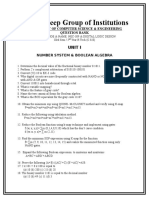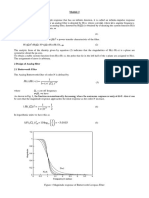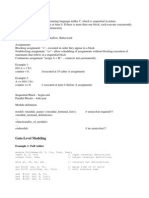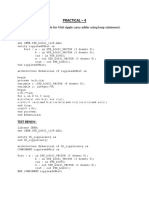VHDL Cheat Sheet Exam 1
VHDL Cheat Sheet Exam 1
Uploaded by
Kevin WilczakCopyright:
Available Formats
VHDL Cheat Sheet Exam 1
VHDL Cheat Sheet Exam 1
Uploaded by
Kevin WilczakOriginal Description:
Copyright
Available Formats
Share this document
Did you find this document useful?
Is this content inappropriate?
Copyright:
Available Formats
VHDL Cheat Sheet Exam 1
VHDL Cheat Sheet Exam 1
Uploaded by
Kevin WilczakCopyright:
Available Formats
1. Implement the following using CMOS logic.
For PUN(Top) P-MOSS (with circle at input) AND Parallel OR - series For PDN(bottom) N-MOSS(no circle) And series OR - parallel 2. Using Boolean algebra or otherwise prove the consensus theorem. (i) XY + YZ +XZ = XY + XZ LHS = XY +XZ + (X+X)YZ = XY+XZ +XYZ +XYZ = XY(1+Z)+XZ(1+Y) = XY+XZ = RHS (ii) (X+Y)(Y+Z)(X+Z)=(X+Y)(X+Z) (XY) + (YZ) + (XZ) = (XY) + (XZ) XY + YZ +XZ = XY + XZ then follow above. 3. Mealy Machine Design. make mealy state diagram (circles with states and arrows for Input/output) present state/next state/ output chart Guidelines (I) States with same next state for a given input, (II)States that are next states of the same state, (III) States that have the same output for a given input. Assignment map transition table K maps for JKFFs and output eqns. Ex.(use 1s for output k map.)
4. Clocked D flip flop, triggered on the rising edge of CLK using transparent D latches & necessary gates. Complete the following timing diagram etc.
5. Describe the design flow of modern digital system design and discuss the scope of VHDL in the CAD/Design automation industry Requirements RTL model synthesizeGate-level Model place and route timing model/ ASIC or FPGA while simulating and testing with test bench in between each step to ensure proper behavior. 6.VHDL module for JK flip flop with (i) 2 inputs J and K, (ii) 2 synchronous preset(S) and Clear(R) inputs , (iii)2 outputs Q and QN. entity JKFF is Process(S, R, CLK) port (S, R, J, K, CLK: in bit; begin Q, QN: out bit); if R = 0 then Qint <= 0 after 8 ns; end JKFF; elsif S = 0 then Qint <= 1 after 8ns; architecture JKFF1 of JKFF is elsif CLKevent and CLK = 1 then signal Qint: bit; Qint <= (J and not Qint) or (not K and Qint) after 10 ns; begin end if; Q <= Qint; end process; QN <= not Qint; end JKFF1; 7. Inertial Delays are intended to model gates and other devices that do not propagate short pulses from the input to the output. Transparent Delays are intended to model the delay introduced by wiring, simply delays an input signal by specified time.
8.What are the different predefined data types in VHDL? - bit 0 or 1 -boolean TRUE or FALSE -Integer An integer in the range (2E31 1) to +(2E31 1) -Real floating point number in the range -1.0E38 to +1.0E38 9.What are the different predefined operators in VHDL? - Binary logical operators and, or, nand, nor, xor, xnor - Relational operators - =, /=, <, <=, >, >= - Shift Operators sll, srl, sla, rol, ror - Adding operators - +, -, &(concatenation)
-Character Any legal VHDL character including upper and lower case letters, digits, and special characters (each must be enclosed in single quotes eg d or 7) -time an integer with units fs, ps, ns, us, ms, sec, min, or hr
- Unary sign operatos - +, - Multiplying operators - *, /, mod, rem - Miscellaneous operators not, abs, **
10. In the following VHDL code A, B, C, and D are all integers that are 0 at time 10 ns. If D changes to 1 at 20 ns specify the times at which A, B, and C will change and the values they will take. process(D) B<= A + 1; ---executes before A changes. begin C <= B after 10 ns; ---executes before B changes. A <= 1 after 5ns; end process; C does not change, B = 1 at 20 + delta ns, A = 1 at 25ns. 11. A DD flip flop except the flip flop can change state (Q+ = D) on both the rising edge and the falling edge of the clock input. The flip flop has a direct reset input, R, and R = 0 resets the flip flop to Q = 0 independent of the clock. Similarly it has a direct set input, S, that sets the flip flop to 1 independent of the clock. Write a VHDL description of a DD flip-flop. Entity DDFF is process(Clk, R, S) elsif Clkevent port (R, S, D, Clk: in bit; begin then Q <= D; Q: out bit); if R = 0 then endif; end DDFF Q <= 0; end process; architecture Behav of DDFF is elsif S = 0 end Behav; begin then Q <= 1; 12. Assuming B is driven by the simulator command Draw a timing diagram illustrating A, B and C if the following concurrent statements are executed.
Force B 0 0, 1 10, 0 15, 1 20, 0 30, 1 35 A <= transport B after 5ns; C <= B after 8 ns; 14.(a)If gate delays are 5ns, what is the delay of the fastest 4 bit ripple carry adder explain calculations. (b)Fastest 4 bit adder (using gates). (a) 1 bit adder = 2(5) = 10ns. 4 bit ripple carry adder delay = 4(10) = 40ns.(b) = 2(5) = 10ns. This is a 2 level sum of products adder that just uses combinational logic. 15. 16 bit carry look ahead adder utilizing the 4-bit adder from fig 4-10 as a component entity CLA16 is signal C: bit_vector (3 downto 1); port(A, B: in bit_vector (15 downto 0); Ci: in bit; alias A0: bit_vector(3 downto 0) is A(3 downto 0); S: out bit_vector(15 downto 0); Co, PG, GG: out bit); alias A1: bit_vector(3 downto 0) is A(7 downto 4); end CLA16; alias A2: bit_vector(3 downto 0) is A(11 downto 8); archetecture Structure of CLA16 is alias A3: bit_vector(3 downto 0) is A(15 downto 12); component CLA4 is alias B0: bit_vector(3 downto 0) is B(3 downto 0); port(A, B: in bit_vector (3 downto 0); Ci: in bit; alias B1: bit_vector(3 downto 0) is B(7 downto 4); S: out bit_vector(3 downto 0); Co, PG, GG: out bit); alias B2: bit_vector(3 downto 0) is B(11 downto 8); end component; alias B3: bit_vector(3 downto 0) is B(15 downto 12); component GPFullAdder begin port(X, Y, Cin: in bit; CaryLogic: CLALogic port map (G, P, Ci, C, Co, PG, GG); G, P, Sum: out bit); CLAa: CLA4 port map(A0, B0, Ci, S0, open, P(0), G(0)); end component CLAb: CLA4 port map(A1, B1, C(1), S1, open, P(1), G(1)); component CLALogic is CLAc: CLA4 port map(A2, B2, C(2), S2, open, P(2), G(2)); port(G, P:in bit_vector(3 downto 0); Ci: in bit; CLAd: CLA4 port map(A3, B3, C(3), S3, open, P(3), G(3)); C: out bit_vector(3 downto 1); Co, PG, GG: out bit); S <= S3 & S2 & S1 & S0; end component; end Structure; signal s0, s1, s2, s3, G, P: bit_vector(3 downto 0); 16.Derive the generates, propogates, the final sum and carry out for a 4 bit CLA. Generates for any bit position i carry will be generated if Ai = 1, Bi = 1 therefore Gi = AiBi Propogates there is a carry in to that bit and at least one of Ai and Bi are 1. Therefore Pi = (AiBi) Carry out - Ci +1 = Gi+PiC i Sum = AiBi Ci 17. 16x16 array multiplier. For any (m x n) array multiplier # and gates = n^2
# Full adders = n(n-2)
# half adders = n
Clk 0 1 1 D X 0 1 Q Q No change No Change 0 1 1 0
18.Explain the idea behind the working of the D latch. Show truith table & circuit implementation. - Level sensitive and transparent. Output depends on clock Clk high: Input passes to output. Clk low: Latch holds its output.
19.Discuss different delays relevant in a sequential circuit. Propagation Time that elapses from the time the clock changes to the time the Q output changes. tphl The propagation delay from high to low tplh The propagation delay from low to high - setup time(tsu) time input D must be stable before the active edge of the clock. - Hold time(th) Time input D must be stable after the active edge of the clock. 20. Implement the following using only NAND gates. ------NAND logic
21. Describe the different levels of abstraction in digital design using a suitable example. -Behavioral Algorithmic, Dataflow. -Structural components interconnections -Physical Implementation 22. Write a complete VHDL module for 4 1 MUX using WHEN statement. Library IEEE; bitout : out std_logic); use IEEE.STD_LOGIC_1164.ALL; end multiplexer4_1; entity multiplexer 4_1 is architecture Behavioral of multiplexer 4_1 is port( i0 : in std_logic; begin i1 : in std_logic; process (i0, i1, i2, i3, sel) i2 : in std_logic; begin i3 : in std_logic; case sel is sel : in std_logic_vector (1 downto 0); when 00 => bitout <= i0; 23.Write a complete VHDL module for a 4 bit unsigned Number Comparator. entity compare is begin port( num1 : in std_logic_vector (3 downto 0); if (num1 > num2) then num2: in std_logic_vector (3 downto 0); less <= 0; less, equal, greater : out std_logic); equal <= 0; end compare; greater <= 1; architecture Behavioral of compare is elsif (num1 < num2) then begin less <= 1; process (num1, num2) equal <= 0;
when 01 => bitout <= i1; when 10 => bitout <= i2; when 11 => bitout <= i3; end case; end process; end Behavioral;
greater <= 0; else less <= 0; equal <= 1; greater <= 0; end if; end process; end Behavioral;
You might also like
- ELEN90055 Control Systems: Midsemester TestDocument2 pagesELEN90055 Control Systems: Midsemester TestMingyue WangNo ratings yet
- Verilog HDL Implementation of Usb To Ethernet ConverterDocument6 pagesVerilog HDL Implementation of Usb To Ethernet ConverterRenukaNo ratings yet
- 10 10 Bit Array MultiplierDocument19 pages10 10 Bit Array MultiplierAnonymous aKmJmu8No ratings yet
- 3-4 SeminarDocument5 pages3-4 SeminarGulzhan ShakirovaNo ratings yet
- Microsoft Testking MS-900 v2020-01-29 by Philip 70qDocument47 pagesMicrosoft Testking MS-900 v2020-01-29 by Philip 70qBogdan ZahariaNo ratings yet
- Homework+ 1+Additional+Questions+SolutionsDocument2 pagesHomework+ 1+Additional+Questions+Solutionsclairejaeger0% (1)
- Digital Electronics 2: Sequential and Arithmetic Logic CircuitsFrom EverandDigital Electronics 2: Sequential and Arithmetic Logic CircuitsRating: 5 out of 5 stars5/5 (1)
- Vlsi Project Report Arithmetic Logical Unit Using Verilog AluDocument7 pagesVlsi Project Report Arithmetic Logical Unit Using Verilog AluAnurag KharwarNo ratings yet
- Digital System Design by Using VERILOGDocument13 pagesDigital System Design by Using VERILOGkpkarthi2001No ratings yet
- VHDL Program: Experiment: 1 Aim: To Write A VHDL Program For: I) 8 Bit ComparatorDocument6 pagesVHDL Program: Experiment: 1 Aim: To Write A VHDL Program For: I) 8 Bit ComparatorVidhya DsNo ratings yet
- Digital Electronics QuestionsDocument8 pagesDigital Electronics QuestionsShivamahendar SunkaNo ratings yet
- Verilog Tutorial For BeginnersDocument4 pagesVerilog Tutorial For BeginnersNovelyn RabinoNo ratings yet
- 19 MooreMealyDocument23 pages19 MooreMealynvsrox100% (1)
- Vlsi Design Using VHDLDocument20 pagesVlsi Design Using VHDLAbhinav ShuklaNo ratings yet
- PISO Verilog PDFDocument5 pagesPISO Verilog PDFSainadh YerrapragadaNo ratings yet
- VHDL MaterialDocument33 pagesVHDL MaterialChutiyaNo ratings yet
- Verilog NotesDocument64 pagesVerilog Notessureshfm1No ratings yet
- Verilog Code For The ALUDocument4 pagesVerilog Code For The ALUraja kesarwaniNo ratings yet
- Registers and CountersDocument28 pagesRegisters and CountersHammadMehmoodNo ratings yet
- Design of Analog FIltersDocument7 pagesDesign of Analog FIltersparshuram kumarNo ratings yet
- VHDL SequentialDocument5 pagesVHDL SequentialSAKETSHOURAVNo ratings yet
- VHDL Fir FilterDocument31 pagesVHDL Fir FilterSyam SanalNo ratings yet
- Adders and MultipliersDocument59 pagesAdders and Multipliersdbanbumani_501791840No ratings yet
- Vlsi World - Verilog Code For RAM & ROM12456Document6 pagesVlsi World - Verilog Code For RAM & ROM12456gssharma888No ratings yet
- Digital Systems DesignDocument2 pagesDigital Systems Designapi-3782519No ratings yet
- VerilogexampleDocument20 pagesVerilogexampleGayathri SankarNo ratings yet
- Red Pitaya - FPGA Ebook Part 2 - Basics of Verilog FPGA Programming LanguageDocument16 pagesRed Pitaya - FPGA Ebook Part 2 - Basics of Verilog FPGA Programming Languagetira2inallNo ratings yet
- Embedded System Design - Bubble Sort Algorithm, Embedded System ImplementationDocument29 pagesEmbedded System Design - Bubble Sort Algorithm, Embedded System Implementationwcastillo100% (1)
- Test Benches in VerilogDocument16 pagesTest Benches in VerilogSharan ChaitanyaNo ratings yet
- Verilog HDL: ModuleDocument9 pagesVerilog HDL: ModuleAvinash ReddyNo ratings yet
- Assignment 7 System Design Through VERILOG - Unit 8 - Week 7 - Test BenchesDocument4 pagesAssignment 7 System Design Through VERILOG - Unit 8 - Week 7 - Test BenchesvijaymtechNo ratings yet
- Sawtooth Wave GeneratorDocument3 pagesSawtooth Wave GeneratorArunNo ratings yet
- HDL Manual 2019 5th Sem E&CE 17ECL58Document77 pagesHDL Manual 2019 5th Sem E&CE 17ECL58vishvakirana100% (1)
- Verilog Introduction: SynopsisDocument7 pagesVerilog Introduction: SynopsisMeghana VeggalamNo ratings yet
- Verilog HDL - 18ec56 AssignmentDocument2 pagesVerilog HDL - 18ec56 Assignmentsureshfm1No ratings yet
- Half and Full Adder Implementation in Verilog (DSD)Document8 pagesHalf and Full Adder Implementation in Verilog (DSD)waqasahmadzNo ratings yet
- EC551-Fall-2011 Advanced Digital Design With Verilog & FPGAsDocument4 pagesEC551-Fall-2011 Advanced Digital Design With Verilog & FPGAsApoorva BhattNo ratings yet
- Cadence Nclaunch LabDocument86 pagesCadence Nclaunch Labsweety987No ratings yet
- Module - 3 DSDVDocument40 pagesModule - 3 DSDVHimabindu SanapaNo ratings yet
- VLSI Lab ManualDocument46 pagesVLSI Lab ManualPriyam JainNo ratings yet
- Laboratory Exercise 9: A Simple ProcessorDocument8 pagesLaboratory Exercise 9: A Simple ProcessorhxchNo ratings yet
- 4-Bit ALUDocument3 pages4-Bit ALUdipendughoshNo ratings yet
- PLL ExperimentDocument6 pagesPLL ExperimentkalscribNo ratings yet
- Verilog Imp...Document105 pagesVerilog Imp...Arun JyothiNo ratings yet
- Digital Logic Design: VHDL Coding For Fpgas Unit 5Document34 pagesDigital Logic Design: VHDL Coding For Fpgas Unit 5Srinivas CherukuNo ratings yet
- Radix-4 Modified Booth's Multiplier Using Verilog RTLDocument10 pagesRadix-4 Modified Booth's Multiplier Using Verilog RTLPrem KumarNo ratings yet
- Altera PWMDocument50 pagesAltera PWMEnrique VillaltaNo ratings yet
- AIM: - Write A VHDL Code For 4 Bit Ripple Carry Adder Using Loop Statement. CodeDocument4 pagesAIM: - Write A VHDL Code For 4 Bit Ripple Carry Adder Using Loop Statement. CodePrashant PathakNo ratings yet
- hls4ml TutorialDocument49 pageshls4ml Tutorialpelayo leguinaNo ratings yet
- Assignment 1Document8 pagesAssignment 1phyrdowsNo ratings yet
- Verilog SAPDocument69 pagesVerilog SAPAustin Tyson DsouzaNo ratings yet
- Design Flow VlsiDocument42 pagesDesign Flow VlsiRahul ShandilyaNo ratings yet
- ECE 301 - Digital Electronics: Sequential Logic Circuits: FSM DesignDocument27 pagesECE 301 - Digital Electronics: Sequential Logic Circuits: FSM DesignSuman BhardwajNo ratings yet
- Asic CH13Document30 pagesAsic CH13Vivek100% (2)
- Design & Verification of AMBA APB ProtocolDocument4 pagesDesign & Verification of AMBA APB ProtocolKrishnajithKjNo ratings yet
- HW1Document11 pagesHW1Tao Liu YuNo ratings yet
- Experiment 4 PCMDocument5 pagesExperiment 4 PCMMs. INDU Ms. INDUNo ratings yet
- D-Flip-flop Using MUX: Digital ElectronicsDocument2 pagesD-Flip-flop Using MUX: Digital ElectronicsTejas KumbarNo ratings yet
- VLSI Lab Manual Exercise ProblemsDocument38 pagesVLSI Lab Manual Exercise ProblemsPrakhar Kumar100% (1)
- Digital Lab Cs 6211 VHDL ProgramsDocument13 pagesDigital Lab Cs 6211 VHDL ProgramsMurugan GNo ratings yet
- EE520 ASIC Design PDFDocument44 pagesEE520 ASIC Design PDFthiendoan_bkNo ratings yet
- Application-Specific Integrated Circuit ASIC A Complete GuideFrom EverandApplication-Specific Integrated Circuit ASIC A Complete GuideNo ratings yet
- Chapter 1 (Cansingnment Account)Document24 pagesChapter 1 (Cansingnment Account)Bravish GowardhanNo ratings yet
- 21ST Century SchoolsDocument2 pages21ST Century SchoolsrebutiacomichaelaNo ratings yet
- Use Equals Sign To Determine Missing Numbers Algebra Level 3 Worksheet - Ver - 3Document13 pagesUse Equals Sign To Determine Missing Numbers Algebra Level 3 Worksheet - Ver - 3Fatima AliuNo ratings yet
- Topic 3Document99 pagesTopic 3Naqib KamarozamanNo ratings yet
- Web - Sciences Complete BookDocument523 pagesWeb - Sciences Complete BookMohammed AatifNo ratings yet
- The True Sabbath PDFDocument32 pagesThe True Sabbath PDFEugenius Divine LoveNo ratings yet
- RI Plan and Tiem Commitment TablesDocument5 pagesRI Plan and Tiem Commitment TablesOsama MZNo ratings yet
- Skittles ProjectDocument4 pagesSkittles Projectapi-299945887No ratings yet
- Personality DevelopmentDocument12 pagesPersonality DevelopmentVarsha GowdaNo ratings yet
- Summary of The Most Important English LessonsDocument16 pagesSummary of The Most Important English Lessonskhadidja.bhNo ratings yet
- Ecological Study Dec 2016 - Prof Bhisma MurtiDocument16 pagesEcological Study Dec 2016 - Prof Bhisma MurtiEvan Permana PutraNo ratings yet
- Design of A 100w Power Amplifier With Darlington Complementary Symmetry Output Power TransistorDocument61 pagesDesign of A 100w Power Amplifier With Darlington Complementary Symmetry Output Power TransistorZachNervesNo ratings yet
- Yic Daily ScheduleDocument2 pagesYic Daily ScheduleRajeshNo ratings yet
- Masters Business Administration Thesis TopicsDocument5 pagesMasters Business Administration Thesis Topicsfjfcww51100% (2)
- Simple JusticeDocument131 pagesSimple JusticewillpopeNo ratings yet
- 4BS0 01 Que 20130522Document24 pages4BS0 01 Que 20130522NavoditteNo ratings yet
- The Nehru DynastyDocument8 pagesThe Nehru DynastyRamsNo ratings yet
- Principles Unit PlanDocument10 pagesPrinciples Unit Planapi-308317958No ratings yet
- Gym Management System SoftwareDocument8 pagesGym Management System SoftwareIntouchGroupNo ratings yet
- 64 - Mindtree Brochures Murex Datamart Performance Optimization PDFDocument4 pages64 - Mindtree Brochures Murex Datamart Performance Optimization PDFpurushottam100% (1)
- Chapter 10 CommunicationDocument38 pagesChapter 10 CommunicationZahir SherNo ratings yet
- Leading Psychiatrist Blows Whistle On ProfessionDocument9 pagesLeading Psychiatrist Blows Whistle On ProfessionpicogyoNo ratings yet
- The Legend of Sleepy HollowDocument43 pagesThe Legend of Sleepy HollowDavid BartonNo ratings yet
- Presented By: Gavneet SinghDocument21 pagesPresented By: Gavneet SinghGagan Deep SinghNo ratings yet
- Kellogg School of Management Strategic Decision-MakingDocument14 pagesKellogg School of Management Strategic Decision-MakinggabboudehNo ratings yet
- Informatica Sequence Generation Techniquesv2Document0 pagesInformatica Sequence Generation Techniquesv2Tata SairameshNo ratings yet

























































































